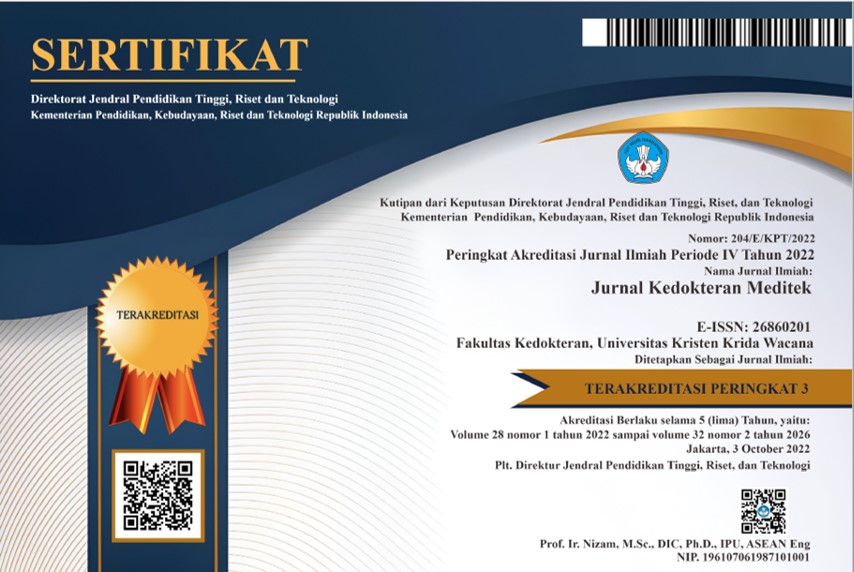Faktor Risiko Prediktor Bakteremia pada Pasien Nekrolisis Epidermal: Evidence-Based Case Report
DOI:
https://doi.org/10.36452/jkdoktmeditek.v28i1.2240Keywords:
bakteremia, nekrolisis epidermal, prediktorAbstract
Nekrolisis epidermal (NE) yang terbagi atas Sindrom Stevens-Johnson (SSJ) dan nekrolisis epidermal toksik (NET) merupakan reaksi simpang obat berat dengan mortalitas tinggi. Penyebab kematian terbanyak pada NE adalah sepsis, namun gejala sepsis tidak spesifik pada NE dan hasil kultur darah membutuhkan waktu lama. Oleh karena itu penting mengetahui prediktor yang berpengaruh terhadap peningkatan risiko bakteremia pada pasien dengan NE. Evidence-based case report ini bertujuan mengetahui faktor prediktor terjadinya bakteremia pada pasien NE berdasarkan literatur. Pencarian artikel menggunakan basis data PubMed, Cochrane, dan Scopus yang relevan dengan pertanyaan klinis untuk kemudian ditelaah. Didapatkan dua artikel kohort yang sesuai. Studi Koh dkk. mendapatkan tiga prediktor yang berpengaruh terhadap kejadian bakteremia pada pasien NE; yaitu hemoglobin ≤ 10 g/dL (odds ratio [OR] 2,4; interval kepercayaan [IK] 95% 2,2-2,6), luas epidermolisis ≥ 10% (OR 14,3; IK 95% 13,4-15,2) dan penyakit komorbid kardiovaskular (OR 2,1; IK 95% 2,0-2,3). Studi De Prost dkk. mendapatkan tiga prediktor yaitu usia > 40 tahun (hazard ratio [HR] 2,5; IK 95% 1,35-4,63), leukosit > 10.000/mm3 (HR 1,9; IK 95% 0,96-3,61), serta LPB ≥ 30% (HR 2,5; IK 95% 1,13-5,47). Epidermolisis yang lebih luas merupakan faktor prediktor terjadinya bakteremia pada NE di kedua studi. Faktor risiko lainnya memerlukan penelitian lebih lanjut.
References
Kirchhof MG, Miliszewski MA, Sikora S, Papp A, Dutz JP. Retrospective review of Stevens-Johnson syndrome/toxic epidermal necrolysis treatment comparing intravenous immunoglobulin with cyclosporine. J Am Acad Dermatol. 2014;71:941–7.
Diana R, Rahayu T, Wirawan E, Dhamayanti M, Irawanto M. Pathophysiology and management of Stevens-Johnson syndrome and toxic epidermal necrolysis. J Gen Proced Dermatol Venereol Indones. 2020;5:28–39.
Cheng L. Current pharmacogenetic perspective on Stevens-Johnson syndrome and toxic epidermal necrolysis. Front Pharmacol. 2021;12:1–17.
Kowalski ML, Asero R, Bavbek S, Blanca M, Blanca-Lopez N, Bochenek G, et al. Classification and practical approach to the diagnosis and management of hypersensitivity to nonsteroidal anti-inflammatory drugs. Allergy Eur J Allergy Clin Immunol. 2013;68:1219–32.
Chong I, Chao A. Stevens-Johnson syndrome/toxic epidermal necrolysis and treatment with a biologic: a case report. Perm J. 2017;21:4–7.
Kongpan T, Mahasirimongkol S, Konyoung P, Kanjanawart S, Chumworathayi P, Wichukchinda N, et al. Candidate HLA genes for prediction of co-trimoxazole-induced severe cutaneous reactions. Pharmacogenet Genomics. 2015;25:402–11.
Sukasem C, Sririttha S, Tempark T, Klaewsongkram J, Rerkpattanapipat T, Puangpetch A, et al. Genetic and clinical risk factors associated with phenytoin-induced cutaneous adverse drug reactions in Thai population. Pharmacoepidemiol Drug Saf. 2020;29:565–74.
Yang Y, Zhang Z, Lu X, Zhu X, Huang Q, Liang J, et al. Occupational toxic epidermal necrolysis associated with dalbergia cochinchinensis: a retrospective comparative study of eight cases in China. Int J Dermatol. 2015;54:1435–41.
Zhao J, Hu L, Zhang L, Zhou M, Gao L, Cheng L. Causative drugs for drug-induced cutaneous reactions in central China: a 608-case analysis. An Bras Dermatol. 2019;94:664–70.
Mockenhaupt M, Roujeau J. Epidermal necrolysis (Stevens-Johnson syndrome and toxic epidermal necrolysis). In: Kang S, Amagai M, Bruckner AL, Enk AH, Margolis DJ, McMichael A, et al., editor. Fitzpatrick’s dermatology. McGraw-Hill Education; 2019. hal. 733–48.
Chaby G, Maldini C, Haddad C, Lebrun-Vignes B, Hemery F, Ingen-Housz-Oro S, et al. Incidence of and mortality from epidermal necrolysis (Stevens–Johnson syndrome/toxic epidermal necrolysis) in France during 2003–16: a four-source capture–recapture estimate. Br J Dermatol. 2020;182:618–24.
Yamane Y, Matsukura S, Watanabe Y, Yamaguchi Y, Nakamura K, Kambara T, et al. Retrospective analysis of Stevens-Johnson syndrome and toxic epidermal necrolysis in 87 Japanese patients - treatment and outcome. Allergol Int. 2016;65:74–81.
Mahri S, Nuary T, Mughni FA, Budianti WK. A four years retrospective study of Stevens Johnson syndrome - toxic epidermal necrolysis treatments in a national tertiary referral hospital. In: Sawitri, Prakoeswa CRS, Ervianti E, Reza NR, Alinda MD, Anggraeni S, editor. 23rd Regional Conference of Dermatology (Asian-Australian) 2018 Incorporating with The 16th Annual Scientific Meeting of the Dermatology and Venerology. Surabaya; 2018. hal. 276.
Suwarsa O, Yuwita W, Dharmadji HP, Sutedja E. Stevens-Johnson syndrome and toxic epidermal necrolysis in Dr. Hasan Sadikin General Hospital Bandung, Indonesia from 2009-2013. Asia Pac Allergy. 2016;6:43.
Mittmann N, Knowles SR, Koo M, Shear NH, Rachlis A, Rourke SB. Incidence of toxic epidermal necrolysis and Stevens-Johnson syndrome in an HIV cohort. Am J Clin Dermatol. 2012;13:49–54.
Brunet-Possenti F, Steff M, Marinho E, Crickx B, Descamps V. Syndrome de Stevens-Johnson au cours d’une primo-infection par le virus d’Epstein-Barr. Ann Dermatol Venereol. 2013;140:112–5.
Lerch M, Mainetti C, Terziroli Beretta-Piccoli B, Harr T. Current perspectives on Stevens-Johnson syndrome and toxic epidermal necrolysis. Clin Rev Allergy Immunol. 2018;54:147–76.
Chung WH, Shih SR, Chang CF, Lin TY, Huang YC, Chang SC, et al. Clinicopathologic analysis of coxsackievirus A6 new variant induced widespread mucocutaneous bullous reactions mimicking severe cutaneous adverse reactions. J Infect Dis. 2013;208:1968–78.
Hsu DY, Brieva J, Silverberg NB, Silverberg JI. Morbidity and mortality of Stevens-Johnson syndrome and toxic epidermal necrolysis in United States adults. J Invest Dermatol. 2016;136:1387–97.
Bastuji-Garin S, Fouchard N, Bertocchi M, Roujeau JC, Revuz J, Wolkenstein P. Scorten: a severity-of-illness score for toxic epidermal necrolysis. J Invest Dermatol. 2000;115:149–53.
De Prost N, Ingen-Housz-Oro S, Duong TA, Valeyrie-Allanore L, Legrand P, Wolkenstein P, et al. Bacteremia in Stevens-Johnson syndrome and toxic epidermal necrolysis: epidemiology, risk factors, and predictive value of skin cultures. Medicine (Baltimore). 2010;89:28–36.
Koh HK, Chai ZT, Tay HW, Fook-Chong S, Choo KJL, Oh CC, et al. Risk factors and diagnostic markers of bacteremia in Stevens-Johnson syndrome and toxic epidermal necrolysis: a cohort study of 176 patients. J Am Acad Dermatol. 2019;81:686–93.
Lipový B, Holoubek J, Hanslianová M, Cvanová M, Klein L, Grossová I, et al. Toxic epidermal necrolysis data from the CELESTE multinational registry. Part II: Specific systemic and local risk factors for the development of infectious complications. Burns. 2018;44:1561–72.
Downloads
Published
How to Cite
Issue
Section
License
Copyright (c) 2022 Shafira Anindya, Parikesit Muhammad, Windy Keumala Budianti

This work is licensed under a Creative Commons Attribution-NonCommercial-ShareAlike 4.0 International License.


















